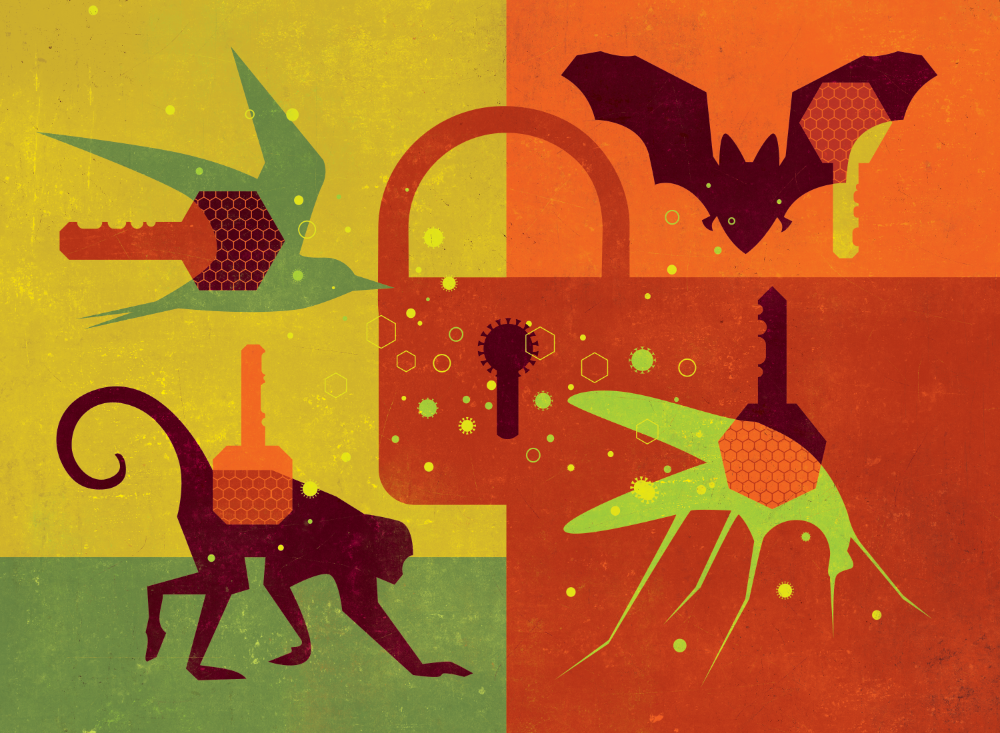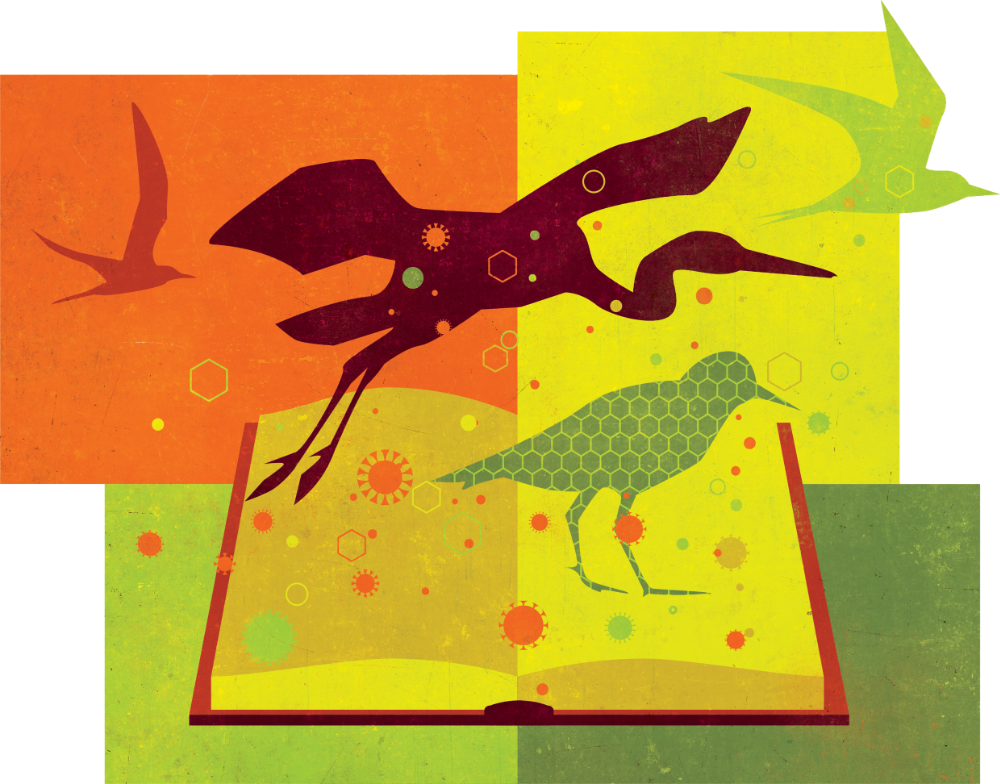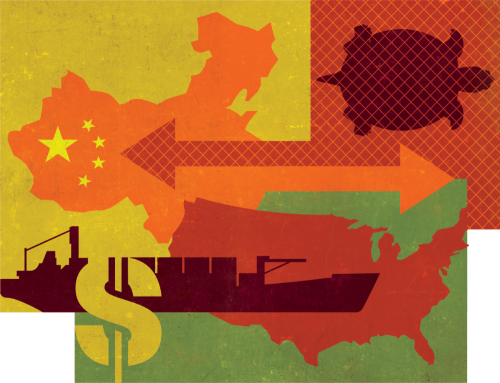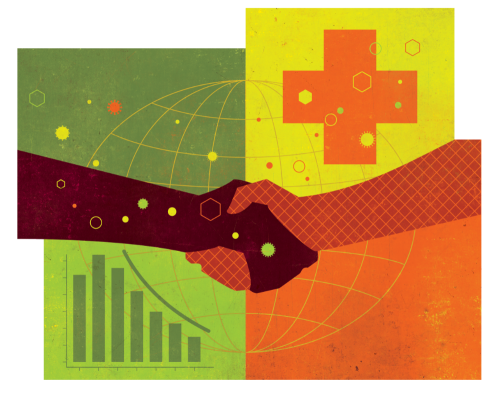How diseases like COVID-19 make the improbable jump from animals to humans, and how humans make it easier for them.
By Todd McLeish
Illustrations by Traci Daberko
When University of Rhode Island herpetologist Nancy Karraker lived in Hong Kong, she spent considerable time visiting its wet markets—and those in mainland China—during her studies of the illegal trade in turtles, frogs, and other animals. She visited similar markets in Thailand, Indonesia, Malaysia, and elsewhere in East Asia. She quickly came to understand why they are called wet markets.
“Everything is wet—the floors, the tables, the people. You can’t help but get splattered when you’re in there,” says Karraker, an associate professor of natural resources science. “Hundreds of vendors are crowded into tight situations. Often you’ll see freshly slaughtered chickens and ducks, piles of bats and other native mammals, cage after cage of mixed species stacked on top of each other, some of which will be slaughtered in front of you.
“You have huge densities of people in these enclosed spaces coming into very close contact with animals that are potentially infected with viruses that may be transmissible to humans,” she adds. “And then you have people living in very high densities, frequently meeting socially, so there’s a very high chance of passing a virus from person to person. And then the virus takes off.”
ORIGINS OF A PANDEMIC
By now it’s a familiar story to many people around the globe, because that’s the likely scenario for how the COVID-19 pandemic got its start—at a wet market in China. But it could have begun that way in almost any country in the world, including the United States, because the trade in wildlife is ubiquitous, and more and more humans are coming into contact with potentially infected animals on a regular basis.
Illegal wildlife trafficking is a $23 billion industry. Legal wildlife trade—regulated by the Convention on the International Trade in Endangered Species of Wild Fauna and Flora and by state, provincial, and national regulations—is a $300 billion business, which includes animals for the pet industry, food, and traditional medicine. The pet trade in the United States accounts for $15 billion of the total legal wildlife trade.
As innocent as the pet trade may sound, animals sold as pets can easily transmit diseases to the many people who handle them along the way—hunters, shippers, sellers, breeders, and buyers among them. The pet industry also has a tremendous impact on populations of native species because so many animals are taken directly from the wild.
Karraker’s studies in China, Indonesia, and Thailand found that illegal turtle harvesting leads to dramatic declines in turtle populations, as well as a skewing of sex and age ratios in the wild, since females and older turtles are often larger and easier to see and collect. “In Indonesia, 80 percent of the turtles there are at risk of extinction because of collection,” she says. “And those turtles are either sold for food or traditional medicine in China or for pets in Europe, Japan, and the U.S.”
The trade in wild animals for use in traditional medicine—rhino horns, bear gall bladders, powdered turtle shell, and much more—is highly lucrative and mostly illegal. And almost none of it has been proven to provide the benefits that buyers seek. “But if Grandpa has cancer and you believe in these things as medicine, then you’ll pay top dollar to save Grandpa,” says Karraker, who taught the University’s first class in wildlife trafficking in spring 2019.
But it’s for local food markets in South America, Africa, and Asia that the vast majority of wild animals are captured and sold. Almost any animal that can be easily trapped or hunted might appear at a market and be sold relatively inexpensively. It’s at these markets, where animals are recently killed and are handled by many people, that zoonotic diseases—those transmitted from animals to people—are most likely to lead to a pandemic.
LOCK AND KEY
Professor Tom Mather, a public health entomologist, uses a common analogy to explain how zoonotic diseases work. He compares them to a lock and key.
“You can’t get into your car without a key, and viruses can’t infect something unless their key lines up exactly with the receptors in the host they’re trying to infect. It’s very precise and very specific,” says Mather, who studies tick-borne diseases and teaches a course about zoonotic disease. “These spillovers from wildlife to people aren’t going to happen willy-nilly. Animals and people are exposed to germs all the time, yet most never result in an infection—much less a pandemic—because germ and possible host don’t contain complimentary keys and locks.”
Most disease-causing agents don’t cross from one species to another because there are too many barriers to entry, but zoonotic disease germs find a way. Most are viruses, because they are more prone to mutation, and it often takes many mutations to allow a disease to make the jump from animal to human and then from human to human. “Animals are probably shedding their germs all the time,” Mather says. “It’s just a matter of whether those germs have the right key to get into something else. Some germs seem to have a master key and can infect lots of different hosts, but there are still limits for a spillover to occur.”

Not all zoonotic diseases create pandemics, of course, because they don’t spread easily among people. Some are delivered to an immune population, others run into what Mather calls a “transmission or infection barrier,” and still others—like avian flu—cannot be transmitted effectively between people. Unlike those with COVID-19, patients infected with severe acute respiratory syndrome (SARS) and Middle East respiratory syndrome (MERS) during the outbreaks of those coronaviruses did not typically transmit them to others before exhibiting symptoms, which enabled those deadly diseases to be contained more easily.
“Maybe the key didn’t match up well enough,” Mather says. “It can’t bulldoze its way through. A virus might make 100 mutations and only one will make the key work.”
According to the Wildlife Conservation Society, about 60 percent of existing human infectious diseases originated in animals. They are typically transmitted in one of three ways: through direct contact with wild or domestic animals; indirectly through the consumption of animal products; or by a vector like a mosquito, tick, or flea.
Although one might assume that consuming an infected animal would be the easiest way to transmit disease from animal to human, Mather believes that’s probably the least likely method, at least if the animal is cooked before eating.
“If they’re cooked, that could inactivate the germs, and stomach acids aren’t typically conducive to most germs’ survival,” he says. “But it depends on where in the host the germ cells are first introduced. The virus has to get into a cell that it can commandeer.”
That’s also why restaurants list warnings on their menus about the risks of eating uncooked seafood. For zoonotic diseases that begin with animals in the marine environment, the transmission usually happens through the consumption of uncooked marine life.
“Zoonotic diseases are the perfect storm situation,” says Marta Gomez-Chiarri, URI professor of fisheries and animal science who studies diseases in shellfish. “You have to have a susceptible host with an immune system that cannot fight the disease; you have to have a pathogen; and you have to have the right environment for the pathogen to cause disease. For most things that cause disease in the marine environment, those pathogens cannot survive in human hosts because of the difference in temperature between the ocean and people.”
One of the most common zoonotic diseases from marine animals is caused by the anisakis worm, a parasitic nematode that lives in the muscle of cod and haddock. If it’s consumed by humans, the worms burrow into the intestine and cause great pain and discomfort. It’s difficult to treat because the treatment typically used to kill the worms in fish can be toxic to humans.
“That’s why there is no cod or haddock sushi. The risk of transmission is just too high,” Gomez-Chiarri says. “But we’re not part of the normal cycle for the parasite to survive. We’re an incidental host, and in most cases, the disease ends with the incidental host and cannot be transmitted.
“In the case of COVID-19,” she adds, “we may have been the incidental host, but the virus mutated so it became transmissible from human to human. Once you get that mutation, you can get more mutations in another host. Most of those mutations do not affect the ability of the virus to cause disease, but some can make it less or more virulent. It’s possible that the virus that came to the U.S. from Europe had experienced mutations that made it even more virulent.”

STUDYING ZOONOTIC DISEASES
Juliet Lamb, who recently finished a postdoctoral fellowship in URI’s Department of Natural Resources Science, is now a Marie Curie Fellow at the Center for Functional and Evolutionary Ecology in France. There, she is studying the zoonotic potential of coronaviruses in seabirds.
“Seabirds are potential vectors for the spread of novel coronaviruses and other diseases among human societies, since they move long distances and cross oceans. They have been implicated in transporting other viruses—especially avian influenza—between geographically disconnected areas,” she says. “The opposite—human-to-wildlife transmission—is also a concern. Some seabird researchers who work on remote islands are worried about going to their field sites this year and potentially transmitting the disease to birds that otherwise wouldn’t come into contact with humans or other mammals.”
Lamb’s research combines a literature review to learn whether coronavirus transmission between birds and mammals has previously been documented; testing samples to evaluate the prevalence of coronaviruses in birds; and an assessment of the role that migratory and social behavior of birds might play in disease dynamics.
Julia McIlmail ’20, who graduated in May with a bachelor’s degree in health studies, was enrolled in Mather’s zoonotic disease class during her final semester. She learned so much, so quickly, that she became an information source for her friends and family as the pandemic unfolded.
“It’s ironic how we were learning about zoonotic diseases in the middle of a zoonotic pandemic,” says McIlmail, who is working with Mather this summer before entering graduate school to study epidemiology. “It’s unfortunate how much science and history seem to be repeating themselves, but I guess everything is cyclical and we were due for a pandemic, as horrible as that sounds.
“We were studying the SARS pandemic-that-never-happened and the pattern of zoonotic disease, and then COVID-19 followed the exact same pattern,” she adds. “A lot of my friends thought it wasn’t going to be a big deal, and then it was.”
THE BAZILLION DOLLAR QUESTION
Whether the pandemic will lead to the curtailment of the wildlife trade and its great risk of future zoonotic diseases and pandemics is what Karraker calls “the bazillion dollar question.” Most countries—including China—already have regulations protecting their native wildlife from capture and sale, but little is done to enforce those rules.

“The thing that needs to happen is that countries like the U.S. need to stop playing such a big role in the trade,” she says. “The U.S. is probably the largest legal importer of animals for pets, and I’m sure we’re a big part of the illegal trade, too. China has eaten most of its native turtles, and now they’re getting them from elsewhere. Increasingly, turtles from the eastern United States are being illegally collected, packaged, and shipped to China, and Americans are making loads of money doing it. That has to stop.”
The one thing Karraker says is not likely to happen in the wake of the pandemic is the shuttering of the wet markets in China and other countries that sell wild animals as food— despite China’s claims that it is doing so.

“I don’t know how they even could shut it down,” she says. “It’s like telling people in Rhode Island that you can’t go to Stop and Shop any more. That’s how they get their food, and they see nothing strange about it.”
Steps can be taken—and must be taken—however, to make the wet markets more sanitary, Karraker says. “Could they package things differently? Could they change their health standards to reduce the risk of disease transmission? Yes.”
Most importantly, she concludes, the issues related to the wildlife trade and zoonotic disease transmission must be taken seriously by all nations and not allowed to return to their former status.
“We’ve seen a couple episodes—like SARS and MERS—that could really have turned into what COVID-19 has turned into, and thankfully they got batted down pretty quickly,” Karraker says. “We’ve gotten a wake-up call with COVID-19 that things can go south very quickly unless they are addressed, and I hope that all countries will think carefully about what their roles are and what they can do to address them.” •
HOW WILL THE WORLD CHANGE POST-PANDEMIC?
For cultural anthropologist Hilda Lloréns, the pandemic provided an opportunity to reflect on anthropological trends and tendencies in human societies.

“Immediately after a disaster, a common community and social response is to cooperate with each other to ameliorate the situation. Disasters bring people together, and there is a period of social reflection and reckoning about how to rebuild or bounce back better,” says Lloréns, associate professor of anthropology. “But like other types of catastrophes, pandemics also lay bare social inequalities, exposing deep political rifts in the social body.
“The duration and impact of the pandemic will likely dictate whether changes in well-established and accepted social behavior, such as handshaking and hugging, will take place,” she continues. “It’s too early to tell what the long-term sociocultural effects of the pandemic will be. But in a capitalist society such as ours, in which the safety net (welfare, health care, and other social programs) has been corroded by neoliberal policies, it is likely that the next few years will be plagued with greater social inequality and suffering.”
“The pandemic’s long-term effect on the economy will depend on how quickly and effectively the virus can be contained.”
–Liam Malloy
From an economic standpoint, the pandemic has been a disaster, with record-breaking unemployment, a dramatic drop in the stock market, a huge decline in consumer spending, and a similar drop in business investment. “There’s not much we can do to prevent a recession,” said Liam Malloy, URI associate professor of economics, in a series of online lectures he presented in April 2020.
He believes that the pandemic’s long-term effect on the economy will depend on how quickly and effectively the virus can be contained. He points to numerous economic parallels between the current situation and the Great Depression and World War II. The Great Depression took more than a decade to recover from; however, the nation ended up in a strong economic position at the end of the war.
“When this pandemic ends, are we going to be in the 1930s, looking forward to seven more years of economic malaise, slow growth, and high unemployment, or in 1945 where people are eager and willing to spend and the economy recovers quickly?” he asks. “That’s an open question.”
One major change he foresees from the pandemic is more support for universal health coverage. Malloy says it doesn’t make sense to link employment and health insurance at a time when so many people have lost their jobs—and have therefore lost their health insurance—due to a health crisis.
“The U.S. is the only rich country without universal health coverage, and that needs to change,” he says. “There are so many reasons to have universal coverage—from humanitarian reasons to civic reasons to economic reasons—and it will be interesting to see whether or not this pandemic leads to that kind of permanent change.”•

Very nice article. As a 1983 graduate of URI with a degree in microbiolgy, I’m pleased to see the clear explanation of disease transmission for the general public. Now as a dentist, it has been exhausting to try to dispel the fiction about Covid that is prevalent in the media and public policy. I believe that as we learn more about the current Covid virus, future public policy can slow the dissemination of inaccurate information because I truly believe that the new pandemic is fear, not science.
Interesting , but mysterious…what is an example of widely disseminated, but inaccurate information? There’s no doubt that FEAR rules print media. The Sunday NYTimes is a FEAR digest, but loaded with fun & novel escapes for the financial “elites”.
Great article! I believe that Julia McIlmail is the same awesome student that I had in my microbiology course at La Salle.
This was a very interesting article that helped to explain the pandemic to the vox populi. I concur with the attitude of unlinking health insurance from employer as I know several people (including myself) that no longer have healthcare insurance because of unemployment. To me this whole pandemic is just so sad.